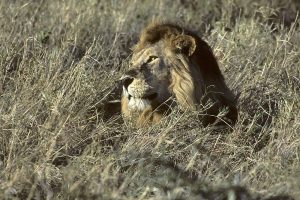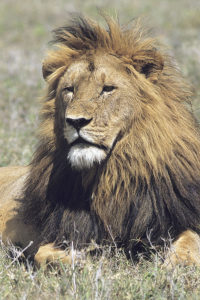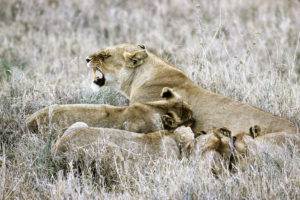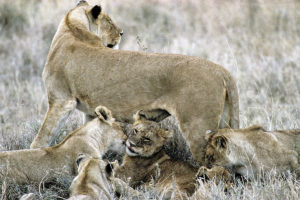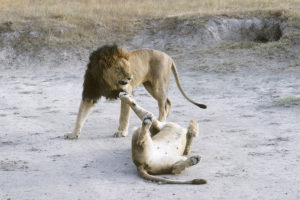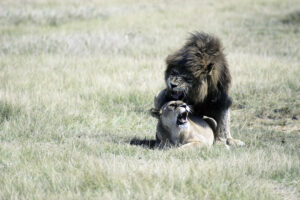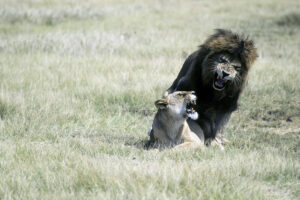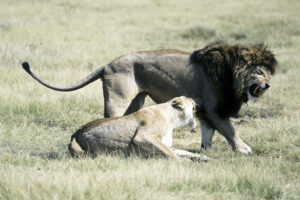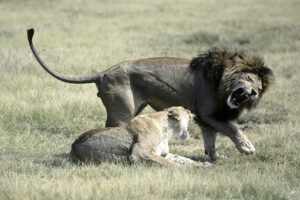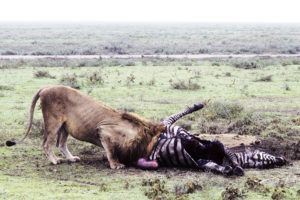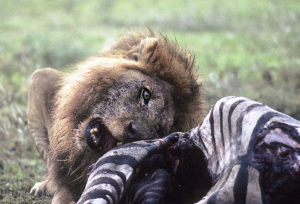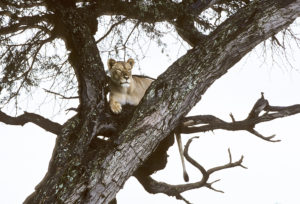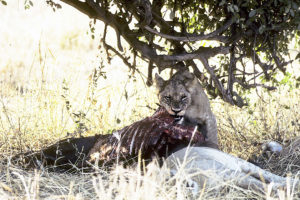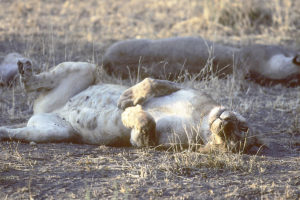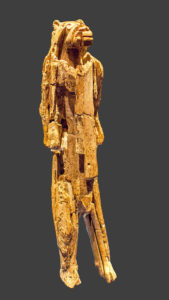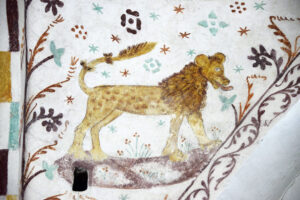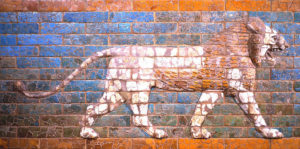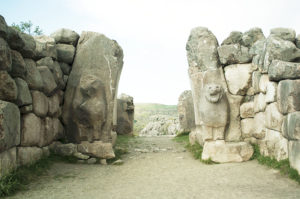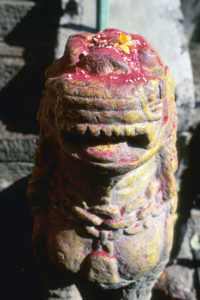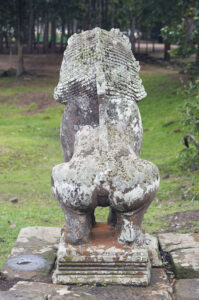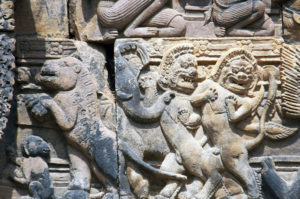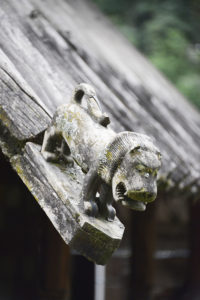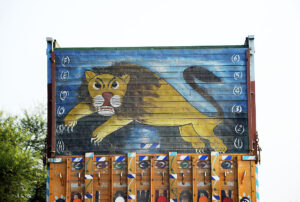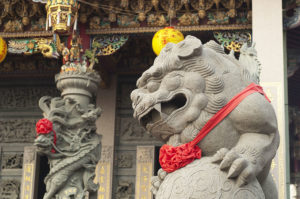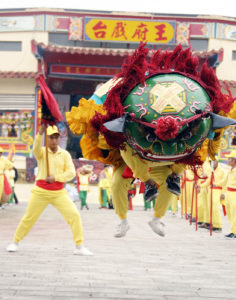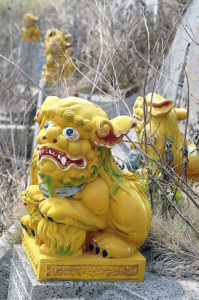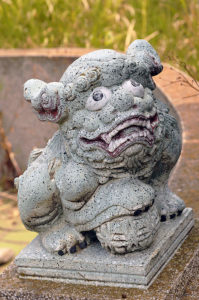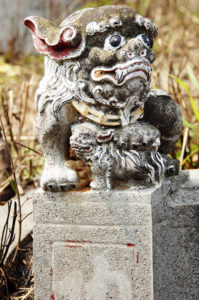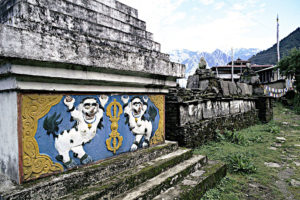Lion – king of the savanna
Golden cat in golden grass, Serengeti National Park, Tanzania. (Photo copyright © by Kaj Halberg)
Often called ’The King of Animals’, the lion (Panthera leo) is indeed a powerful and immensely strong animal, but it is not the largest carnivore. The polar bear (Ursus maritimus) and some subspecies of the brown bear (Ursus arctos) are larger, and the Siberian tiger (Panthera tigris ssp. altaica) is also slightly larger than the lion.
The title was probably bestowed on the lion because of the male’s mane, which makes him look very impressive. The mane is a large growth of hair around the neck and down the chest, and often a little way down the back. No other cat species has a mane. The mane makes a male seem larger than he actually is, without the disadvantage of a larger weight, which would require more food. A large mane is a signal to other males that here comes a powerful animal, which shouldn’t be challenged, even if the challenging male is in fact larger than his opponent, but has a smaller mane. The mane also gives some protection during fights among males.
A male lion with a large mane is indeed a very impressive animal. – Serengeti National Park. (Photo copyright © by Kaj Halberg)
A social cat
Unlike most other cat species, lions are very social, living in so-called prides, comprising 4-12 related lionesses with their offspring, and 1-6 males, often brothers or half-brothers, which are not related to the females.
In a pride, lionesses do most of the hunting, during which they co-operate. One or two commence walking slowly towards a flock of herbivores, while others have crept through the grass and are now waiting in ambush for the advancing lionesses to drive an animal towards them. Lions also often steal prey from other animals, including leopard (Panthera pardus), cheetah (Acinonyx jubatus), and spotted hyaena (Crocuta crocuta). A study from the Ngorongoro Crater, Tanzania, has shown that more than 80% of all carcasses that lions were feeding on had in fact been killed by hyaenas.
Usually, all animals in a pride eat simultaneously, but if the prey is not large enough to feed them all, the stronger males – even if they didn’t participate in the hunt – often chase away females and cubs. If prey is scarce, all members of a pride starve, and, being the weakest, cubs often succumb. On average, an adult male requires about 7 kilograms of meat per day, a lioness about 5 kilos.
The role of male lions is to protect the pride against enemies, mostly foreign males who attempt to take over the pride. If they succeed in ousting the resident males, the new males will kill all small cubs in the pride. Formerly, this behaviour was a mystery to scientists, but studies have shown that if a litter of cubs die, the lioness quickly gets into oestrous again. In this way, by killing the cubs, the new males can father offspring faster and thus propagate their own genes.
When a lioness is in heat, one of the males will follow her closely and guard her against other males. Copulation is initiated by head rubbing and sniffing each other’s genitals. Then the male mounts, biting the hind neck of the lioness. However, he must dismount quickly, as the lioness often becomes exceedingly aggressive right after mating. The pair may copulate as many as 50 times in a 24-hour period.
If prey is scarce, the pride is starving, and, being the weakest, cubs often succumb. – Masai Mara National Park, Kenya. (Photos copyright © by Kaj Halberg)
This lioness is suckling her cubs, which is obviously a painful process. – Serengeti National Park. (Photo copyright © by Kaj Halberg)
After feeding, the cubs are playful. (Photo copyright © by Kaj Halberg)
After sniffing a lioness’ urine, this male is grimacing in what is called flehmen. A sensitive area in its mouth is able to detect whether the female is in heat. – Ngorongoro Crater, Tanzania. (Photo copyright © by Kaj Halberg)
When a lioness is in heat, she and a male will often leave the pride for a period. This playful lioness is inviting a male to mate, Ngorongoro Crater. (Photos copyright © by Kaj Halberg)
Mating lions, Ngorongoro Crater. Ejaculating, the male quickly dismounts, as the lioness suddenly becomes very aggressive. (Photos copyright © by Kaj Halberg)
Seven or eight subspecies – or fewer
In former days, 12 living subspecies of the lion were recognized, mainly based on body size, mane appearance, and geographic distribution. As male lions vary exceedingly, even within a pride, several of these subspecies have been declared invalid. Today, only eight subspecies are accepted by most authorities, and some of these, including the Cape lion, ssp. melanochaita, may also be invalid. The systematic relationship among African lions is still not completely resolved, whereas the status of the Asiatic lion as a distinct subspecies, ssp. persica, is widely accepted.
Older males are often ousted from the pride and must fend for themselves. This lone, ageing male is feeding on a rotting carcass of a plains zebra (Equus quagga ssp. boehmi), Serengeti National Park. (Photos copyright © by Kaj Halberg)
Young lions, resting on a rocky outcrop, called Simba Kopjes (‘Lion Heads’), Serengeti National Park. (Photo copyright © by Kaj Halberg)
Widely exterminated
About 15,000 years ago, lions were distributed throughout Africa, southern Europe, and across the Middle East to India. Around 300 B.C., it was still found in Greece, and until c. 1900 in the Middle East and Pakistan. In northern Africa, Europe, and Asia, the lion is now extinct, with the exception of about 300 Asiatic lions, which survive in Sasan Gir National Park, Gujarat, north-western India.
The lion is still fairly common in eastern and southern Africa, mainly in national parks and game reserves. A new threat is poaching, the aim of which is to deliver lion parts to the insatiable market for Chinese traditional medicine, as the tiger, which was originally the preferred ‘victim’, has almost been exterminated (described on the page Folly of Man).
This lioness in Serengeti National Park has a gaping wound on her nose, the result of an encounter with a spotted hyaena. (Photo copyright © by Kaj Halberg)
Lions usually stay on the ground, but occasionally they climb trees, especially in areas with many tsetse flies. – Chobe National Park, Botswana. (Photo copyright © by Kaj Halberg)
Unusual experience with lions
Many lions live in Tarangire National Park, northern Tanzania. In this park, my companions and I had a hair-raising nightly experience with lions, related on the page Travel episodes – Tanzania 1990: Lions in the camp.
In a dense scrub in Tarangire National Park, four lionesses and four large cubs are gorging themselves on a white-bearded wildebeest (Connochaetes taurinus ssp. mearnsi). (Photo copyright © by Kaj Halberg)
Having finished their meal, the lions are resting, their distended bellies pointing into the air. (Photo copyright © by Kaj Halberg)
Man-eating lions
Old or injured lions sometimes become man-eaters, usually because they are not able to kill their natural prey. Humans are slow and weak, thus being easy prey for a lion.
It seems that man-eating instances have increased greatly in later years. It has been reported that, between 1990 and 2005, at least 563 villagers were attacked and many eaten by lions in rural areas of Tanzania. The main reason may be that the increasing human population forces people to move further into the bush, where they establish farmland and, simultaneously, exterminate natural prey species of the lion.
The most famous incident regarding man-eating lions took place in Kenya in 1898, when the British were constructing a railway from Mombasa to Nairobi, using mainly Indian labourers. Lt. Col. John Henry Patterson was in charge of the project. When construction of a bridge across the Tsavo River took place, two male lions began stalking the workers’ campsite, dragging coolies from their tents at night and devouring them.
The workers made campfires and erected thorn fences around their camp to keep the man-eaters out, but to no avail. It seemed that these lions had no fear of fire, and they always managed to make their way through the thorn fences. Patterson tried to stalk the lions on foot, but as he was a very inexperienced hunter, the lions got away unharmed. After several repeated attacks, hundreds of workers fled, and work on the bridge came to a halt.
Patterson now constructed a trap with a separate enclosure, which contained coolies to attract the lions, but they ignored the trap, which was then abandoned. Some months later, one of the lions entered the trap out of curiosity, hereby triggering the locking mechanism. Several workers fired at it, but only managed to shatter the locking mechanism, whereupon the lion escaped, bullets whistling around its ears. Patterson spent countless nights on a platform in a tree, hoping to shoot the lions. After repeated unsuccessful endeavors, he shot one on December 9, 1898, and twenty days later the second one. The labourers could now return safely, and the bridge was completed. (Source: Patterson, 1926)
Patterson claimed that, during the nine months of construction, c. 135 people fell victim to the Tsavo Man-eaters, but it seems that this number is grossly exaggerated. A recent study of the two stuffed man-eaters, which are today kept in the Chicago Field Museum, indicates that ‘only’ c. 35 humans were eaten by the lions.
The reason for these two lions to become man-eaters is not clear. Peterhans & Gnoske (2001), as well as Patterson (2004), speculate the following three theories:
An outbreak of rinderpest (a cattle disease) in 1898 may have decimated the usual prey of the lions, forcing them to find alternative food items.
The lions may have been accustomed to human flesh by finding bodies of slaves at the Tsavo River crossing, which was often used by slave caravans, bound for Zanzibar.
Inadequate cremations of Hindu railroad workers could invite scavenging by the lions.
Lions in mythology and folklore
Throughout history, Man has been in awe of large, powerful cats, and in many cultures, including the Egyptian, the Olmec, the Mayan, and the Andean civilizations, the were-cat, a creature with the body of a cat and the face of a human, was often a symbol of fertility.
The lion has been widely used as a symbol of power in various cultures and mythologies, as a heraldic symbol of power in countless coat-of-arms, and in art and folklore.
The main source in this section is various pages on en.wikipedia.org.
Europe
The earliest known depiction of an animal is an ivory figurine from the Hohlenstein-Stadel Cave, southern Germany. In German, this sculpture is called Löwenmensch (‘lion man’), as it depicts a human with the head of a lioness. It is estimated to be from the Aurignacian Culture, at least 32,000 years old. In the so-called Chamber of Felines in the famous Lascaux Caves, southern France, a 15,000-year-old wall painting depicts a mating cave lion pair.
In Greek mythology, the Nemean lion was a vicious monster, living in Nemea, Peloponnese. This lion could not be killed with weapons of mortal people, as its huge golden fur was impervious to attack. Its claws were sharper than swords and could cut through any armour. Eventually, this monster was killed by the Greek hero Heracles, who strangled it with his bare hands. Subsequently, he wore the lion’s pelt as a magic cloak, which made him invulnerable.
According to a tale in the Talmud, Chullin 59b, Rabbi Joshua ben Hananiah informs Roman Emperor Hadrian about a giant lion, living in the forest of Bei Ilai – a lion so huge that the space between its ears measures 9 cubits (corresponding to more than 4 m). The emperor orders the rabbi to call forth this lion, to which he reluctantly agrees. At a distance of 400 parasangs (c. 2,400 km) from Rome, the lion roars, causing all pregnant women to miscarry and all the walls of Rome to fall down. At a distance of 300 parasangs (c. 1,800 km), the lion again roars, and this time all the front teeth and molars of Roman men fall out, and even the emperor himself falls from his throne. He begs the rabbi to send the lion back, and, praying, he manages to make it return to its abode.
This ivory carving, called Löwenmensch (‘lion man’) is the earliest known depiction of any animal. (Photo: Dagmar Hollmann, public domain)
Mural painting, depicting a lion, Elmelunde Church, Møn, Denmark. (Photo copyright © by Kaj Halberg)
Africa
In Ancient Egypt, the deity of war was a lioness, and several of the goddesses had feline features, including Bastet, Mafdet, Menhit, Pakhet, and Tefnut. The huge Sphinx, near the Giza pyramids, is the largest were-cat in the world.
In certain African cultures, the lion was a symbol of power, and some rulers included the term ‘lion’ in their title. One example was Marijata, of the Mali Empire (c. 1235-1600), who was called ‘The Lion of Mali.’
According to local mythology, Ndiadiane Ndiaye, the legendary founder of the Waalo Kingdom (1287-1855), in present-day Senegal and Mauritania, was raised by lions, returning to his people, part man, part lion, to unite them, using the knowledge he learned from the pride.
In Ethiopian folklore, the Lion of Judah was a symbol of Emperor Haile Selassie (1892-1975), born Tafari Makonnen Woldemikael, and also known as Ras Tafari.
In many African folktales, lions have low intelligence and are often tricked by other animals.
In historic times, the lion was distributed all over northern Africa, but has since long been exterminated from this area. – This relief, depicting a male lion, was seen in the Death Temple of Queen Hatsepsut, Egypt. (Photo copyright © by Kaj Halberg)
Shoeshine boys, gathered in front of a sculpture in Addis Abeba, Ethiopia, depicting the Lion of Judah, a symbol of Emperor Haile Selassie. (Photo copyright © by Kaj Halberg)
West Asia
In Ancient Mesopotamia, from the Sumerian to the Babylonian Empire, the lion was associated with kingship. Many reliefs, made from glazed bricks, which adorn the walls of the road, leading up to the Babylonian palace, depict lions, including the so-called Striding Lion.
About 1600 B.C., the Hittites established an empire, centred around the city of Hattuşa, the ruins of which are situated near the present town of Bogazkale, central Anatolia, Turkey. This empire reached its peak around 1350-1300 B.C., during the rule of King Suppiluliuma I, when the major part of Anatolia, as well as what is today northern Lebanon, Syria, and Iraq, were conquered. One of the entrances to the palace in Hattuşa was leading through the once imposing Lion Gate, thus named due to the lion sculptures in front of the entrance.
The Babylonian Striding Lion. (Photo: Public domain)
In 2006, when this picture was taken, not much was left of the once imposing Lion Gate in Hattuşa. The face of the lion to the left was restored in 2011. (Photo copyright © by Kaj Halberg)
South Asia
In Hindu mythology, the second avatar (incarnation) of the great god Vishnu is Narsingh (‘man-lion’), a creature with a lion’s head and paws, and a man’s body. He is often depicted, killing the terrible demon king Hiranyakashipu, who threatened to kill his own son Prahlad, who was a faithful devotee of Vishnu.
The shakti (female aspect) of the great Hindu god Shiva is Devi, also named Parvati, Sati, Uma, Kali, or Durga, who is worshipped as the Mother Goddess. She is often depicted, riding on her mount, which is either a lion or a tiger.
Singh is an ancient Vedic name, meaning ‘lion’. This name was originally only used by Rajputs, a proud Hindu caste in Rajasthan, India. Following the formation of the Khalsa Sikh Brotherhood in 1699, Guru Gobind Singh wished all Sikhs to adopt the name Singh.
The Lion Capital of Ashoka was adopted as the official emblem of India in 1950. This capital, depicting four lions, standing back to back, was originally the symbol of the four truths of Buddhism. It dates back to the reign of Emperor Ashoka (272-238 B.C.), and was originally placed atop the Ashoka pillar at the sacred Buddhist site Sarnath, where Siddharta (later called ‘The Buddha’) gave his first lesson.
This rather gaudy illustration, depicting Narsingh, killing the demon king Hiranyakashipu, is an example of Indian wall paper. Would you like it on your wall? – The many-headed cobra behind Vishnu is his protector. (Illustration: Public domain)
This relief in the Mukteswar temple complex in Bhubaneswar, Odisha (Orissa), depicts the Hindu goddess Durga, who, riding on her lion, is battling against a terrible demon king, Mahishasura, who has taken the shape of an elephant. However, he is not much to look at, compared to the mighty lion! (Photo copyright © by Kaj Halberg)
This lion sculpture is guarding outside a temple in Dakshinkali, Kathmandu Valley, Nepal, dedicated to the Hindu goddess Kali. Marigold petals, rice grain, and red dye have been presented as offerings to the image. The red dye may represent blood, as Kali is fond of blood offerings. (Photo copyright © by Kaj Halberg)
Khmer sculpture, depicting a lion, Bayon, Angkor Thom, Cambodia. (Photo copyright © by Kaj Halberg)
Part of a Khmer relief in Banteay Srei, Angkor, Cambodia, in which the demon king Ravana is shaking the abode of the Hindu gods, Mount Kailash, causing gods and animals to become horror-stricken, in this case two lions, an elephant, a tiger, and a monkey. (Photo copyright © by Kaj Halberg)
Carved lion – detail of a Hadimba Temple in Naggar, south of Manali, Himachal Pradesh, India. The Hadimba legend is related in detail on the page Religion: Hinduism. (Photo copyright © by Kaj Halberg)
This marble lion is guarding the Hindu temple Karna Mata Mandir in Deshnok, Rajasthan, India. (Photo copyright © by Kaj Halberg)
Painting, depicting a lion, on the backboard of a truck, Haryana, India. (Photo copyright © by Kaj Halberg)
Far East
The lion is a common motif in Chinese art, and, although it has never lived in Taiwan, it occurs abundantly in Taiwanese Daoist temples in the form of a mythological creature, which often acts as a protector. Many sculptures depict male lions with a paw placed on a globe-like item. This globe in fact depicts an embroidered ball. In the old days, balls, made from discarded clothes, were presented by children as offerings to temples – a symbol of yang (light forces) and friendship.
During Daoist festivals, so-called lion dances often take place in front of temples. As a rule, this dance is performed by two men, hidden under a gaily coloured cloth, which acts as the body of the lion, whereas a lion mask is held by the man in front. During a more acrobatic form of lion dance, two men, hidden beneath a lion cloth, jump between small metal plates, placed on poles, which are often rather tall.
Sculptures, depicting lions, are also often placed as guardians on Daoist graves.
The snow lion is a mythical creature of Central Asia, which, according to local belief, ranges over mountains and glaciers. It symbolizes strength, fearlessness, and joy.
These sculptures, adorned with red ribbons, depict a lion and a dragon, guarding the entrance to a Daoist temple in the town of Donggang, Taiwan. Note that the lion has its paws placed on a ball (see text above). (Photo copyright © by Kaj Halberg)
Lion dance, performed at the Fushing Temple, Xiluo (top), and at the Samlong Temple, Siao Liouchou Island, both in Taiwan. (Photos copyright © by Kaj Halberg)
Acrobatic lion dance on poles, Kaohsiung, Taiwan. (Photos copyright © by Kaj Halberg)
Lion sculptures are often placed as guardians at Daoist graves, here in Taichung, Taiwan. (Photos copyright © by Kaj Halberg)
The base of this chorten (Tibetan style Buddhist stupa) at Tharke Ghyang, Helambu, central Nepal, is adorned with reliefs, depicting snow lions. – Chortens and other Buddhist structures are described on the page Religion: Buddhism. (Photo copyright © by Kaj Halberg)
References
Patterson, B.D. 2004. The Lions of Tsavo: Exploring the Legacy of Africa’s Notorious Man-Eaters. McGraw-Hill
Patterson, J. H. 1926. The Man-Eating Lions of Tsavo. Field Museum of Natural History, Chicago
Peterhans, J.C.K. & T.P. Gnoske 2001. The science of man-eating among lions (Panthera leo), with a reconstruction of the natural history of the man-eaters of Tsavo. Journal of East African Natural History 90: 1-40
(Uploaded March 2020)
(Latest update February 2023)
